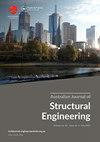RC walls in Australia: displacement-based seismic design in accordance with AS 1170.4 and AS 3600
IF 0.9
Q4 ENGINEERING, CIVIL
Australian Journal of Structural Engineering
Pub Date : 2021-07-03
DOI:10.1080/13287982.2021.1954306
引用次数: 2
Abstract
ABSTRACT Displacement-based methods, such as a non-linear static pushover analysis (e.g. the capacity spectrum method), have many advantages compared to traditional force-based design methods. However, implementing a non-linear analysis and design method in accordance with the Australian Standard for concrete structures (AS 3600) introduces many difficult technical issues into the design, of which the standard provides little guidance. The aim of this study is to provide a framework and general guidance for designers who wish to perform non-linear displacement-based analysis methods for RC wall buildings. The paper will present how these methods can be used in accordance with the Australian Standard for earthquake actions (AS 1170.4) to assess seismic compliance and then provide recommendations for the requirements stipulated by AS 3600, which includes an experimentally validated tension stiffening model, nonlinear stress-strain material curves, mean material properties and material strain limits. The paper is concluded with a case study example of how a displacement-based seismic assessment can be performed using a typical case study building.澳大利亚的钢筋混凝土墙:根据AS 1170.4和AS 3600的基于位移的抗震设计
与传统的基于力的设计方法相比,基于位移的方法,如非线性静态推覆分析(如容量谱方法)具有许多优点。然而,按照澳大利亚混凝土结构标准(AS 3600)实施非线性分析和设计方法,给设计带来了许多困难的技术问题,标准对这些问题的指导作用很小。本研究的目的是为那些希望对钢筋混凝土墙体建筑进行非线性位移分析方法的设计师提供一个框架和一般指导。本文将介绍如何根据澳大利亚地震作用标准(AS 1170.4)使用这些方法来评估地震合规性,然后为AS 3600规定的要求提供建议,其中包括实验验证的拉伸加劲模型,非线性应力-应变材料曲线,平均材料性能和材料应变极限。最后,本文给出了一个案例,说明如何使用典型的案例研究建筑进行基于位移的地震评估。
本文章由计算机程序翻译,如有差异,请以英文原文为准。
求助全文
约1分钟内获得全文
求助全文
来源期刊

Australian Journal of Structural Engineering
ENGINEERING, CIVIL-
CiteScore
2.50
自引率
0.00%
发文量
31
期刊介绍:
The Australian Journal of Structural Engineering (AJSE) is published under the auspices of the Structural College Board of Engineers Australia. It fulfils part of the Board''s mission for Continuing Professional Development. The journal also offers a means for exchange and interaction of scientific and professional issues and technical developments. The journal is open to members and non-members of Engineers Australia. Original papers on research and development (Technical Papers) and professional matters and achievements (Professional Papers) in all areas relevant to the science, art and practice of structural engineering are considered for possible publication. All papers and technical notes are peer-reviewed. The fundamental criterion for acceptance for publication is the intellectual and professional value of the contribution. Occasionally, papers previously published in essentially the same form elsewhere may be considered for publication. In this case acknowledgement to prior publication must be included in a footnote on page one of the manuscript. These papers are peer-reviewed as new submissions. The length of acceptable contributions typically should not exceed 4,000 to 5,000 word equivalents. Longer manuscripts may be considered at the discretion of the Editor. Technical Notes typically should not exceed about 1,000 word equivalents. Discussions on a Paper or Note published in the AJSE are welcomed. Discussions must address significant matters related to the content of a Paper or Technical Note and may include supplementary and critical comments and questions regarding content.
 求助内容:
求助内容: 应助结果提醒方式:
应助结果提醒方式:


